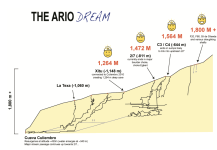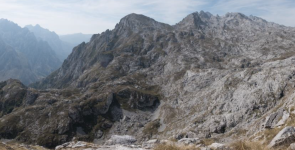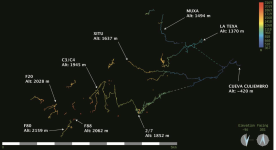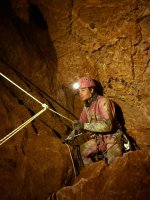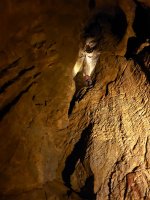A write up of my last few days on the Ario trip this year:
Three days of caving in a row were really taking their toll.
Day one was a trip down 10/9 - a cave in an interesting area above upstream 2/7 and downstream C4. In the shaft bashing guide, 10/9 was described as having multiple routes off at the bottom, and not definitely concluded, so Sandy and I went for a look. After the pitches and moderately awkward rifts we arrived at "Pipsqueak", a pretty narrow-looking vertical squeeze. Sandy passed this with relative ease, and I lowered myself in. After a few adjustments, things weren't looking good. "I don't think I can do this, Sandy", I called down. No reply; he was out of earshot. Rather than sitting and waiting, I had a few more goes, eventually sliding through. I would pay for this in bruises.
The passage soon led to a junction where I had seen Sandy turn left, following the water. Pausing there, it became apparent that the draught was coming from the right-hand passage. After Sandy returned, confirming that the stream could not be followed without some enlargement, we went to take a look at the avens that the draught seemed to originated. A few metres up, routes split and we continued our ascent. Each climb was OK, and before long I found myself about 15 m up in a series of interlinked shafts. Continuing upwards, I followed the fresh air until at 25 m up with walls of dubious quality I lost my nerve and made my retreat. It wasn't a great lead but I hadn?t killed it. After an easier return through Pipsqueak, Sandy looked at another aven adjacent to the last pitch. Unfortunately this petered out to nothing about 15 m up. On our way out we realised that the draught seemed to have completely reversed, which was not the best sign, but we had plenty of bruises as souvenirs for our day.
Day two saw our Israeli friends heading home, so we took over from them down 27/9. I had visited the cave two years previously and been really impressed by the draught at the bottom, which sadly emerged from a too-tight meander. Yuval and Reuven had spent a couple of days applying significant vigour to widen the meander and had made some good progress. Sandy and I continued their work, ?enjoying? a day of lying on our sides in the rift, arms outstretched ahead of us, adding more bruises. Come the end of the day we could see down into an enlargement ahead. To me it looked like there would be room for several people in the space I could see, but some more work would be needed before we got there.
Day three was initially more of the same. We finally enlarged the rift sufficiently to enter the space I had seen the previous day. I had hoped we might be able to climb down from here into a further enlargement, so needless to say we were disappointed to see that the space was nowhere near as large as I had thought, and Sandy quickly reported back that the rift was completely choked below. I was pretty convinced at this point that we were about to confirm the 4 days of rift enlargement as wasted, but there was a small corner we still couldn?t quite see the end of. Sandy soon solved that with the help of a lump hammer, and I crawled upwards before being faced with a narrow, downward-sloping, calcited rift leading to what looked like a dead end. Still, it was draughting and looked just manageable. I attempted the squeeze feet-first, and I think it is only the second time I have ever had to make sure there were no folds in my oversuit in order to fit through, but fit through I (eventually) did, and to my surprise the passage took a sharp turn to the right before enlarging significantly. Once Sandy had joined me, we explored beyond, now in a spacious multi-level rift. A clamber down a couple of levels led us to ledges overlooking significant drop below where, in the absence of any rope or bolting gear, we spent some time gardening in preparation for the first descent the following day. We couldn?t see the bottom.
And so, after 3 days of caving resulting in the largest number of bruises I have ever had, we found ourselves heading through the enlarged rift again, but this time with real excitement. And a tackle bag each. We had estimated the first drop from the pitch head to be 15 m, with a larger drop below that. Our estimates seemed reasonable for once, and the luxury of good rock on both sides of the rift meant the descent was straightforward, and we were grateful to ukCaving for the generous donation of Spanset rope (see 1st photo below). After the first drop a large window in the side of the shaft was clearly visible ahead, but we elected to keep heading down to begin with. We decided to name the pitch ?Foot Hang?, following Dave?s readings about the risks of Super Caves the night before.
We were somewhat disappointed to see the trickle of water that had accompanied us down the (30m ?) shaft flowed into a tight rift at the bottom, but the height of the rift meant we weren?t too short of options at this point. Sandy initially elected to follow the water while I chose a level in the rift about 2 m up and we both made progress, albeit tight and awkward caving, but it soon became apparent that significant progress at these levels was not to be. Sandy had reached a squeeze over a pool that he declared too tight, and I had spent a long time contorting myself through a section of rift that was far too tight for me to wear a helmet into a slight enlargement, only to see that the sharp bend ahead was even tighter. We decided to go back to the base of the shaft and reassess our options.
Looking at the rift from the base of the pitch showed that it extended more than half way up the shaft, to a clear enlargement about 20 m above us. Sandy prussiked up and reached the enlargement after a pretty significant swing. Whilst waiting at the bottom I chose to try a photo. ?Can you just hang still there??, I shouted up to Sandy as he clung on to the rock at the end of his swing. Thankfully he obliged, meaning we at least had some sort of record of what we had found (2nd picture below). I was optimistic of his chances of progress in the rift, but after just a couple of minutes he shouted down that there was no way through.
For the sake of thoroughness, and to keep warm, I decided to climb up the rift while Sandy descended from above. I was optimistic when I saw that the rift split several metres above the floor into what appeared to be an oxbow, but sadly there was still no way through. I continued upwards to about 10 m off the floor, finally reaching a point where I could get into the rift with only minor difficulty - much better than the rest of it. I shouted down that this seemed to be the widest point I could find, and slowly continued onwards, each corner looking like it would be impassable. This continued for what seemed like ages, but was probably not all that far in hindsight. Progress was almost entirely sideways, with a couple of real squeezes, some sharp hairpins, and no shortage of loose rock.
At this point I was very aware of our remoteness. We were the only two people in the remaining team of 4 on the mountain that could fit into the entrance of the cave, let alone the other narrow sections. No one else had been through the enlarged rift way above us, or down the pitches, or even knew of the existence of the committing rift we were in. Thankfully the rift gradually enlarged, and finally we were looking down a strongly draughting pitch head into a much bigger space below. The multitude of levels in the rift meant that on our return we had to be careful to mark the level we had progressed at; at the time it didn?t feel as if there was a guarantee we would progress to the same point again. After a brief debate as to whether the easily accessible window we had passed previously would be a preferable option, we decided to stick with following the still-strong draught and drop the pitch at the end of the rift. This meant a strenuous return through the rift with tackle. An appropriate name for the rift seemed to be ?Ario Reality?, a nod to the collective dream the Ario Caves Project likes to promote.
Once back through Ario Reality, we were quickly down the next pitch of 15 m or so. The pitch was spacious enough, but what was most striking was the complete absence of any noise. Somewhere in the rift we had left the route of the water, and the sound of trickling that had accompanied us for almost the entire cave had left us. ?The Sound of Silence? seemed an appropriate title for this latest pitch. Time was getting on at this point. It was gone 5 pm, and our nominal callout was the 8 pm dinner at the refugio. We wanted to return with a clear account of any continuation, so we traversed forwards in the now wider passage over chocked boulders below before we looked down into yet another black void in the rift below us, the strong, cold draught still blowing in our faces. We did not have enough time or rope for this pitch, but at least we could return with a categorically going cave. ?Darkness My Old Friend? was the obvious title to give our vantage point given the name of the previous pitch.
It was now 5:30 and we had to get a move on. We were guaranteed to be slightly late by this point but were aiming to minimise any worry from Martin and Dave on the surface. We reached the entrance at about 7:45, just in time for the rain to start. We got well and truly drenched by a huge thunder storm on our way back to the refugio, but our spirits were high. We would leave Ario with a big, going cave to return to.
In terms of the big picture, it is a cave that will almost certainly drop into upstream 2/7 or downstream C4, and in either case would provide a significantly lower entrance than those known already, potentially making it valuable for revisiting or pushing deep leads. However, in somewhere as well explored as Ario it seems easy to get carried away by the big picture and to forget the here and now, or to focus on the destination at the expense of the journey. We go on caving expeditions to enter previously unexplored passages, wherever we might find them and however they fit into the wider context. We enjoyed a fantastic couple of days of exploration and the way on is open for whoever returns next time to do exactly the same.
?to travel hopefully is a better thing than to arrive, and the true success is to labour.?
Robert Louis Stevenson, Virginibus Puerisque, 1881



